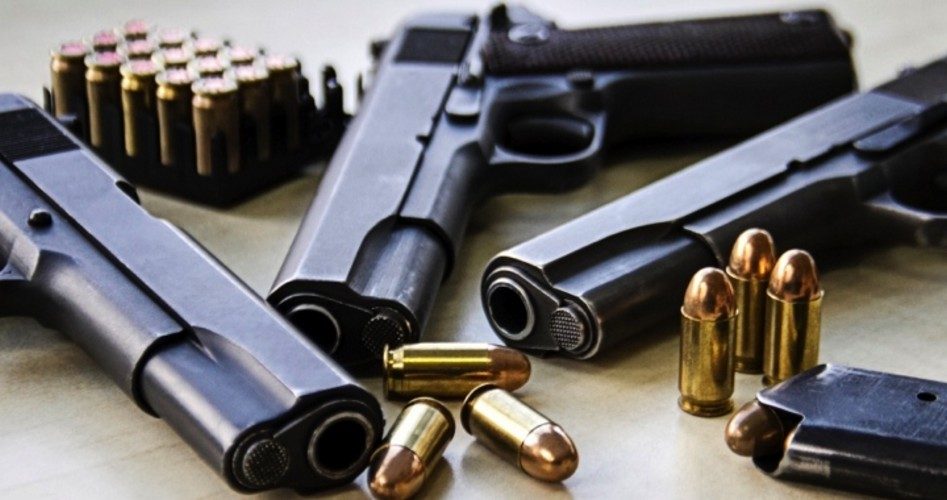
Gun-related crimes are becoming less frequent in Virginia even as firearm sales in the state continue to rise, countering observers’ claims that new gun regulations will reduce homicides, robberies, and other violent crimes. Commenting on the trend, one local criminologist stressed his interest in the findings “given the current rhetoric about strengthening gun laws.”
All in all, crimes committed with firearms in Virginia collectively decreased for a fourth consecutive year, while gun sales climbed to a new record in 2012 with 490,119 firearms purchased — a 16-percent increase over 2011, according to data compiled by the Richmond Times-Dispatch. Last year major gun-related crimes fell to 4,378, five percent lower than the previous year, with a three-percent drop in homicides committed with handguns, a seven-percent decrease in robberies involving handguns, and an 11-percent reduction in robberies committed with all firearms.
Observing data over the past seven years, total gun sales in Virginia have increased an astonishing 101 percent, while crimes involving the use of firearms have plunged 28 percent during that period. Omitting rifle and shotgun sales — which can distort figures owing to the rarity of their use in crimes — crimes committed with handguns dropped 22 percent, despite handgun sales climbing by 112 percent from 2006 to 2011.
“This appears to be additional evidence that more guns don’t necessarily lead to more crime,” said Thomas R. Baker, a criminology expert and assistant professor at Virginia Commonwealth University’s L. Douglas Wilder School of Government and Public Affairs. “It’s a quite interesting trend given the current rhetoric about strengthening gun laws and the presumed effect it would have on violent crimes.”
While Baker was reluctant to contend that people should reject all future gun laws, he noted that the sharp drop in crime “really makes you question if making it harder for law-abiding people to buy guns would have any effect on crime.”
Critics of the Times-Dispatch report have disputed the findings, claiming that the relationship between gun crime and legal firearms sales is not convincing. “Guns sold incident to a background check are less likely to be involved in crimes than guns sold without a background check,” says Josh Horwitz, executive director of the national gun-control group Coalition to Stop Gun Violence. “If people who buy those guns and have a background check, and keep those guns and don’t sell them, then you would not expect that those guns would affect the crime rate.”
But regardless of Horwitz’s objections, patterns revealing decreased crime rates owing to increased gun sales (as well as weakened gun regulations) are nothing new, as similar trends have become evident throughout the country. In 1998, for example, Massachusetts passed legislation that was touted as the most aggressive gun-control effort in the United States, including provisions that barred semiautomatic “assault” weapons, that instituted stringent new licensing rules, and imposed severe penalties for storing guns unlocked.
The 1998 legislation precipitated a sharp decrease in the legal use of guns in Massachusetts. Within only four years, active gun licenses plummeted, with 1.5 million active gun licenses in 1998 dropping to a mere 200,000 in 2002. Unfortunately, the law that imposed strict regulations on law-abiding gun owners led to a disastrous increase in criminal activity.
“Since 1998, gun crime in Massachusetts has gotten worse, not better,” the Boston Globe reported earlier this year. “In 2011, Massachusetts recorded 122 murders committed with firearms — ‘a striking increase from the 65 in 1998.’ Other crimes rose too. Between 1998 and 2011, robbery with firearms climbed 20.7 percent. Aggravated assaults jumped 26.7 percent.”
According to John R. Lott, Jr. of National Review, President Obama deserves some credit (albeit inadvertently) for the noteworthy drop in violent crimes in 2009, as his election sparked a sharp increase in gun sales. During that time, murder rates fell by 7.4 percent and robberies dropped by nine percent. Lott reported:
Gun sales started notably rising in October 2008, and sale really took off immediately after Obama won the presidential race: 450,000 more people bought guns in November 2008 than bought them in November 2007. That’s over a 40 percent increase in sales. By comparison, the change from November 2006 to November 2007 was only about 35,000. Over the last decade, the average year-to-year increase in monthly sales was only 21,000.
The higher sales continued well beyond November 2008: about 3.15 million more people bought guns in the 14 months after the election than in the preceding 14 months. The National Instant Criminal Background Check System, or NICS, doesn’t tell us how many guns each person bought, just the number of people who bought them. Most likely, though, gun sales rose by more than the number of people who purchased them.
Lott explained the pattern in his 1998 book More Guns Less Crime, affirming that “criminals are deterred by higher penalties” — meaning, increased gun ownership presents a greater risk that a criminal will confront a victim who is armed.
Lott also noted the impact that concealed handgun laws have had on crime over the years. “There is a strong negative relationship between the number of law-abiding citizens with permits and the crime rate — as more people obtain permits there is a greater decline in violent crime rates,” Lott explained in an interview with the University of Chicago about his book. “For each additional year that a concealed handgun law is in effect the murder rate declines by 3 percent, rape by 2 percent, and robberies by over 2 percent.”



